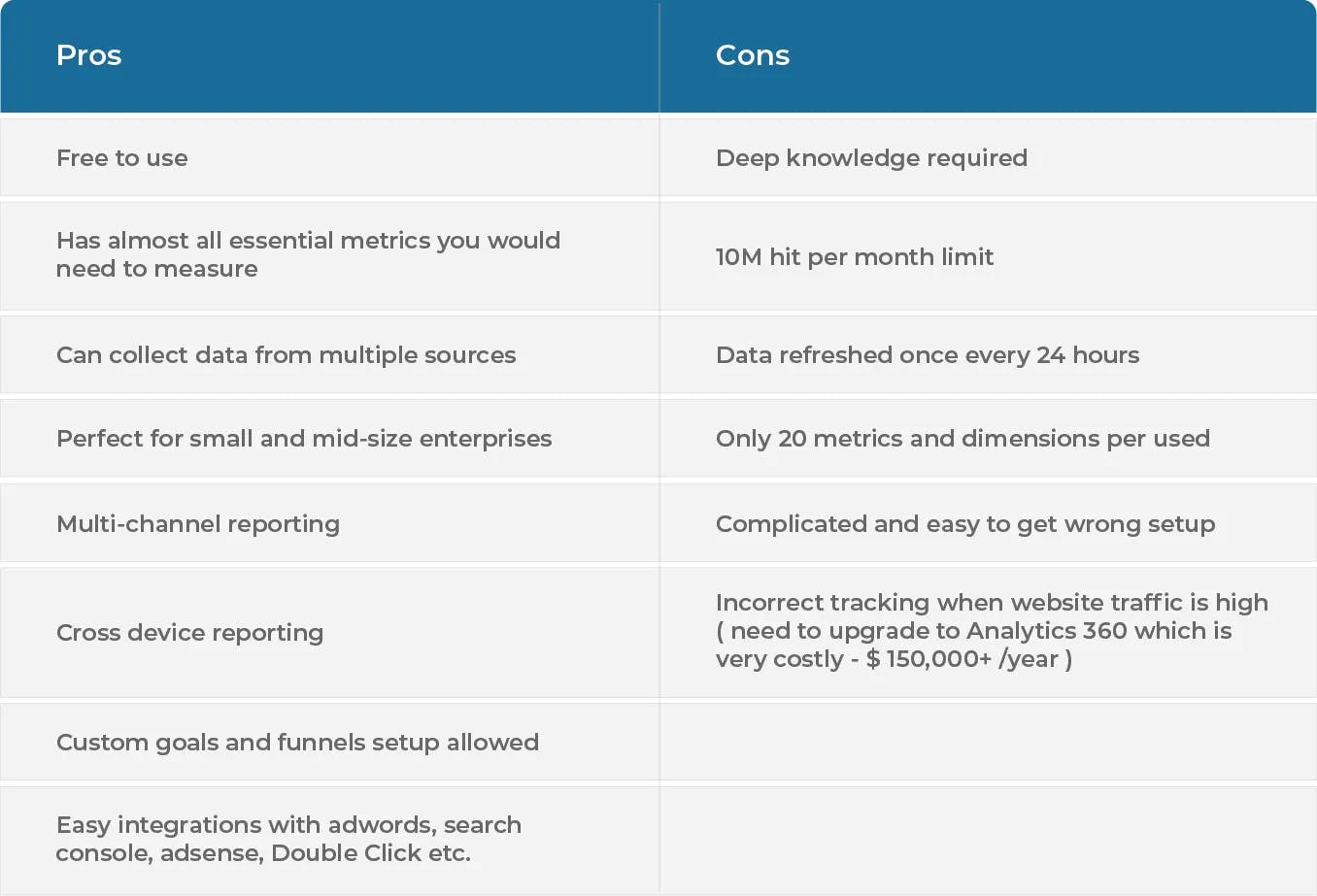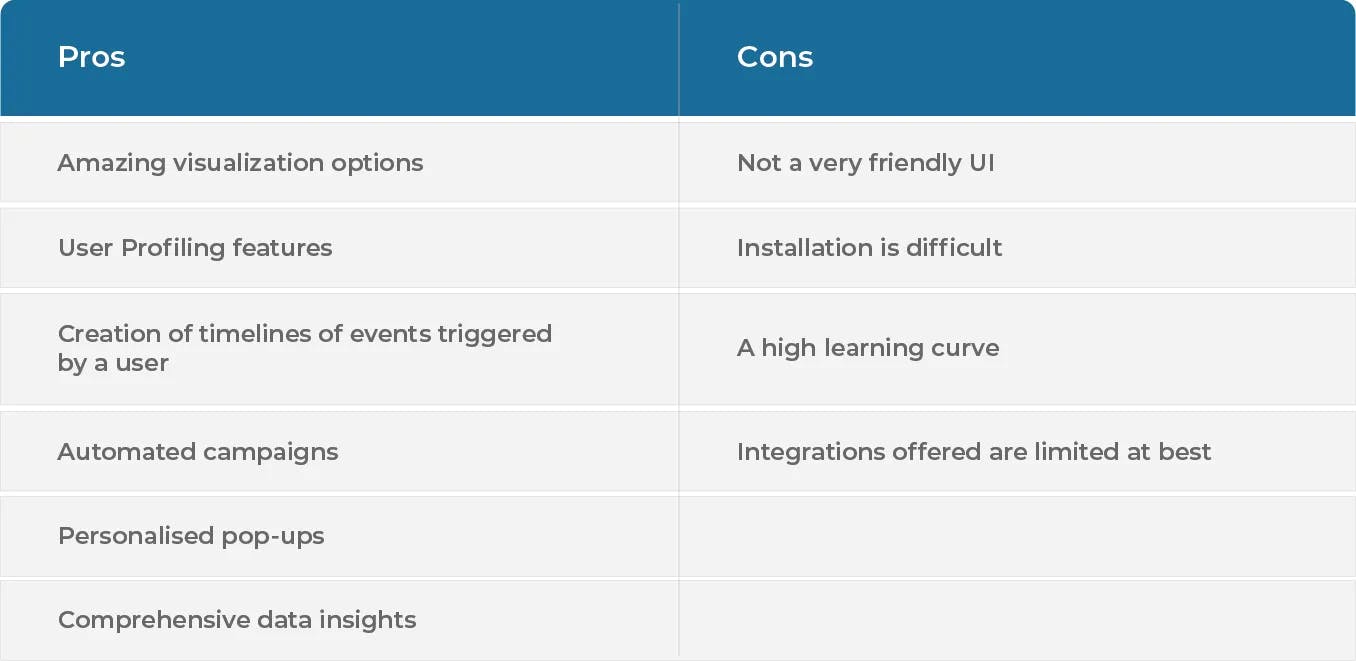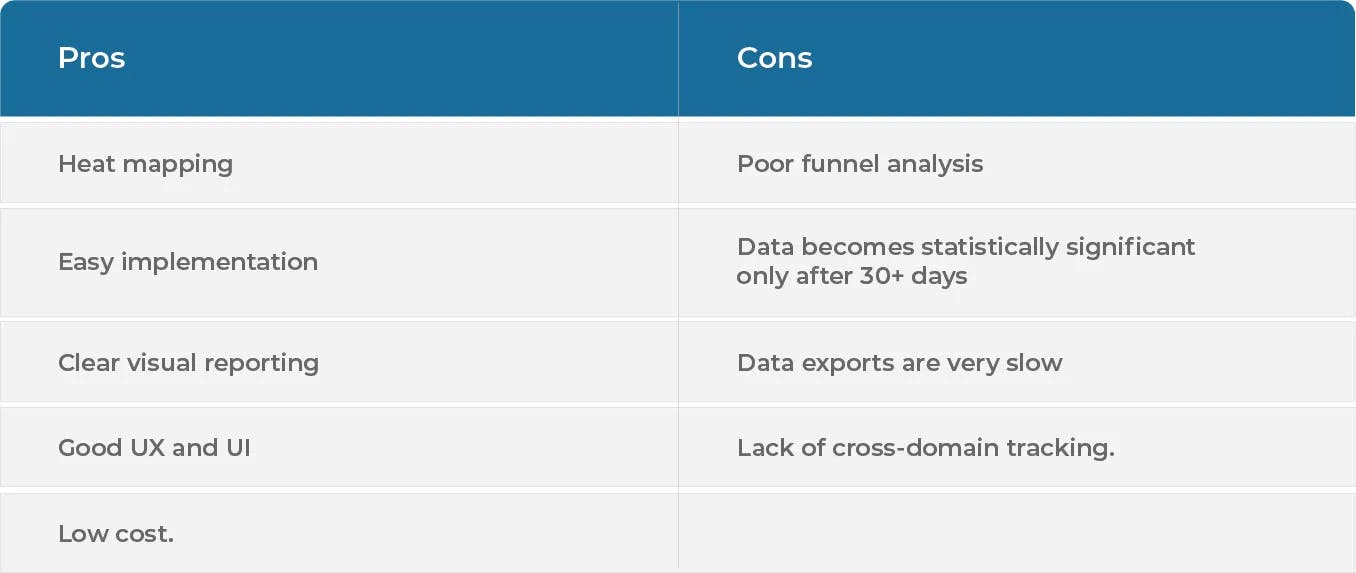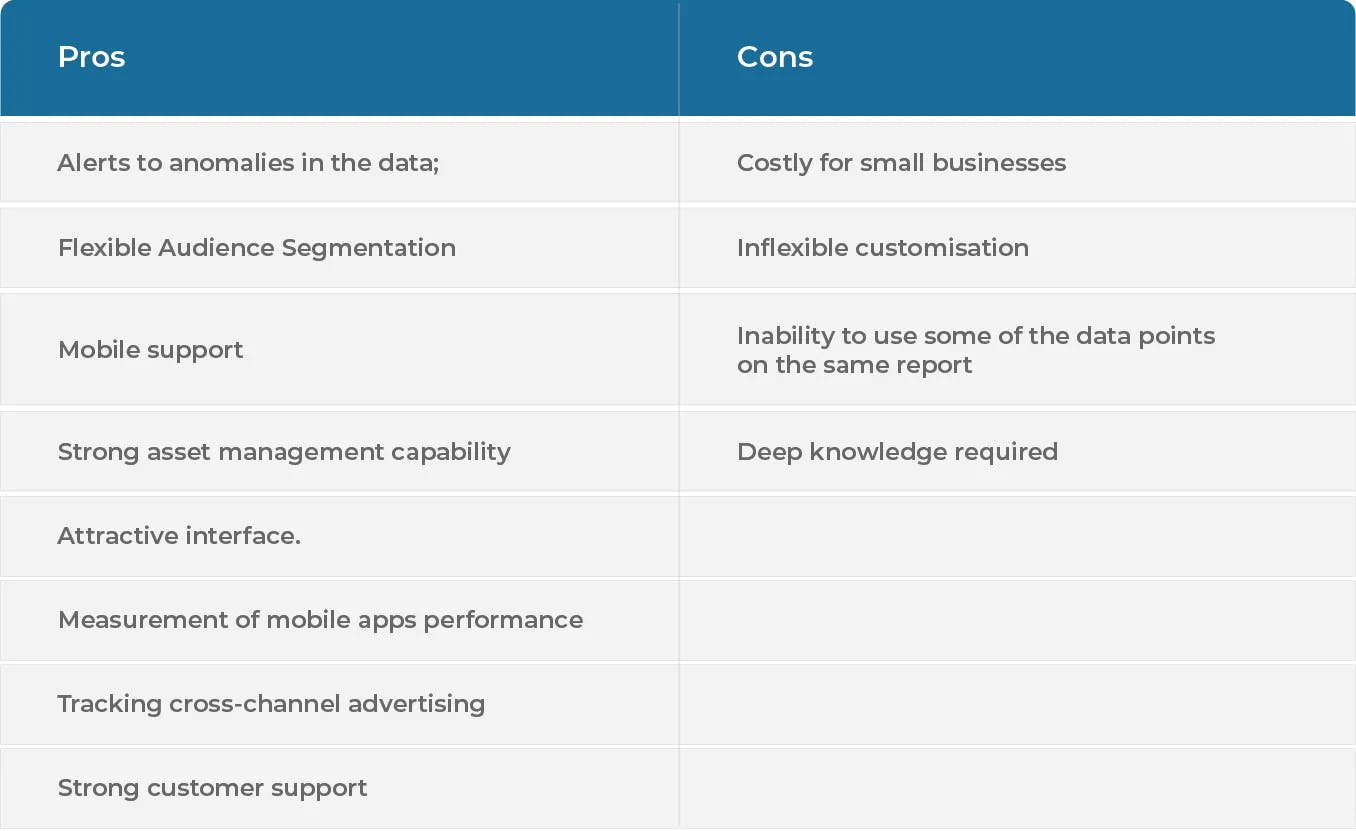Tailor made for your business objective
Before choosing an analytics tool, you need to introspect with relevant organizational stakeholders – what are your key business objectives today? After 2 years? Which data points will be highly essential for you to mark your progress toward your business objective? A crystal clear understanding of your business objective is critical, and it should ultimately dictate your choice of an analytics tool, not vice-versa.
Easy to use interface
There are a lot of stakeholders in an organization, and not all of them will have the technical capabilities or the inclination to make sense of a complex tool. Therefore, the user interface and experience should be dead simple to navigate so that anyone in your organization can use it and draw insights that will help better their work and ultimately positively impact the organization's growth.
Multi source tracking for data
As of today, a single user click on your website leads to repercussions on your website and various allied tools and dashboard. As you scale, more and more data is created daily in increasing complexity on different spreadsheets, tools, and dashboards.
A robust analytics tool should be adaptable enough to collate data from multiple sources, structure it and draw insights in an easily consumable fashion.
Easy to customize
Each business and organization is unique in terms of its goals and requirements. So as we move ahead, the format of one-size-to-fits-all doesn't work anymore.
Tools need to be adaptable and should have the capacity to be customized according to the organization's specifications.
For example, an ecommerce store 'X' might have requirements that focus more on performance marketing data analysis. In contrast, the other ecommerce store 'Y' might want the tool to be focused more on website performance.
Tools need to be adaptable and easily customizable.
Every business has unique requirements, and according to their specifications, every company might need its ecommerce analytical tool with customization.
Scalability
The ultimate goal for any ecommerce store will be – growth. Let's assume ecommerce store 'X' has 5 employees and sees an MAU base of 5,000 on their website. Tool 'Alpha' works very well for them. But consider the case 2 years down the line where the MAU is now 5,00,000 and employees are 200; the same tool should work in a similar or better capacity for your store.
The possibility to encompass scale is crucial while working with an analytics tool.
So, we have catered to some top-notch, sought-after tools list for data analysis, which will benefit all your ecommerce business necessities. So, let's dive into it.
1. Google Analytics
GA is one of the most classic tools used by almost 80% of all websites worldwide. But along with that, 80% of these users need to improve in making the best out of this amazing tool.
GA gained extreme popularity with ecommerce users mainly due to its dead simple and easy-to-navigate interface and best-in-class user experience.
Also, it's free! Apart from this, there is a ton of documentation and help available online, both by Google and third-party websites, on how to add tracking codes, configure reports, segment audiences or set up goals – basically anything to get you to become a GA pro. Google has an in-depth course about GA as well on Google Analytics Academy.
Tracking retail performance with GA for ecommerce stores is very easy as it provides custom metrics. Among these metrics are the following:
- Purchase number
- ATV( Average transaction value)
- Total revenue
- Conversion rate
- Per Session value
Also, GA easily integrates with leading ecommerce platforms like Shopify, Magento, Woo Commerce, Big Commerce, 3d cart, and more.
The in-service search is another brilliant feature. With this, you can ask Google Analytics a question like 'The total number of purchases in Jan 2020' and receive the collated data.
One of the biggest cons of GA is the complicated setup.
Incorrectly added tracking codes or other mistakes can create false final reports, and you would overlook the mistakes until it's late – especially if you are a self-taught amateur.

2. KISSMetrics
KISSmetrics main USP is its accumulation and monitoring of information on visitor behavior.
The system is extremely robust in collecting traits of every single user, such as the history of all ad campaigns which lead the user to your website, all the activities and clicks the user did on your website, the timeline of all the events triggered by the user, and history of their property. Such a collection of data becomes very critical in optimizing performance marketing campaigns and overall customer experience.
These functions of this ecommerce analytics tool are beneficial for building marketing strategies, detecting trends and patterns –
- Funnel, activity, cohort, attributions, and other reports;
- Group Contact Lists;
- Availability of testing and staging sandboxes;
- A/B Tests, Retention Reports;
- Customer Profile
The free setup guidance and email support offered by KISSmetrics are market-standard, intuitive, and responsive.

KISSmetrics has a 14-day free trial. The pricing plans start from $500 per month for the Growth plan and go to $850 for the power plan.
Still, KISSmetrics is a favorite tool for many ecommerce players due to its integrations with platforms like Shopify, Magento, Chargify, Mailchimp, etc.
3. Crazy Egg
The main USP of the Crazy Egg ecommerce analytics tool is the creation of a heatmap that provides an in-depth analysis of the website. The heatmap allows tracking areas on a website your visitors hover, blind spots of the website, how users scroll on your website, and where exactly they click. Crazy Egg is extremely useful for performance marketers and UX designers to identify areas that can be improved to boost conversions and re-work areas that reduce conversions.
The user interface is amicable and easy to navigate. Along with the behavioral market feature, there are a tonne of other features –
- Scroll maps
- Click heatmaps
- Confetti Reports (with charts of daily/monthly activity statistics)
- A/B Testings
- Snapshots
- Overlays

4. Adobe Marketing Cloud
The main USP of the Adobe Marketing Cloud is the combined data from CRM, website analytics, and 3rd party data to give a single view of the customer.
Adobe promises to provide an extremely personalized experience to the customer – showing the right things at the right time to the right customer. AMC analytics tool allows real-time tracking and measurement of targeted campaigns. It also measures email marketing performance. Audience segmentation is another key feature for AMC, which allows automated ad campaign setups via rules.

5. UNBXD
Unbxd's search product comes with a whole range of features to revamp your website's search engine and show relevant results tailored to each visitor, providing a personalized experience for each visitor and ultimately boosting conversions.
The AI–ML algorithms used by Unbxd enable an unforeseen level of relevance for each visitor and have many new-to-the-market features –
- Contextual relevance – Unbxd uses a Machine Learning model – Named Entity Recognition (NER) – which tokenizes each search query to map it to the desired attributes and return the most relevant products with high precision. It goes beyond simple text-pattern matching techniques.
- Query Category Predictor – Unbxd enables the prediction of categories relevant to a shopper, even if their search queries do not explicitly tie to a particular category.
- Intelligent Fallback – Showing relevant products if the products queried for are unavailable in the catalog.
- Autocorrect/Autosuggestion – Auto Correction of typographical errors and autosuggest to complete the query while typing by the shopper and still fetch relevant results, maintaining contextual relevance.
- 1:1 Personalization – Unbxd builds visitor profiles based on brand, price, and category affinities to deliver specially selected assortments that help engage visitors better and lead to more conversions.
- Rank products better – Unbxd's Learning to Rank model data is captured in real-time to optimize for higher conversions.
- Ranking insights – It enables website owners to measure product rankings, assess the effectiveness of a campaign, and find out why certain products appear in certain positions.
- Other features – Unbxd provides a dashboard for merchandisers to manage catalogs and run campaigns, along with a robust data analytics add-on.
Ecommerce is a really cut-throat business to be in right now, with massive amounts of dollars being pumped into the market by small to huge players. So choosing the right set of tools is extremely important.
Each website's use case is different, considering the budget, business scale, products, industry, tech stack, marketing stack, etc.
Careful consideration must be given to each factor while choosing the right tools for your business.
Don't hesitate to contact our experts if you are interested in discovering more about how Unbxd can help your business.
Conclusion
Ecommerce is a really cut-throat business to be in right now, with massive amounts of dollars being pumped into the market by small to huge players. So choosing the right set of tools is extremely important.
Each website's use case is different, considering the budget, business scale, products, industry, tech stack, marketing stack, etc.
Careful consideration must be given to each factor while choosing the right tools for your business.
Don't hesitate to get in touch with our experts if you are interested in discovering more about how Unbxd can help your business.






